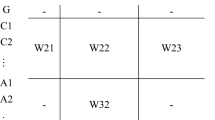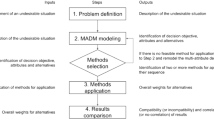Abstract
Analytic network process (ANP) addresses multi-attribute decision-making where attributes exhibit dependencies. A principal characteristic of such problems is that pairwise comparisons are needed for attributes that have interdependencies. We propose that before such comparison matrices are used—in addition to a test that assesses the consistency of a pairwise comparison matrix—a test must also be conducted to assess ‘consistency’ across interdependent matrices. We call such a cross-matrix consistency test as a compatibility test. In this paper, we design a compatibility test for interdependent matrices between two clusters of attributes. We motivate our exposition by addressing compatibility in Sinarchy, a special form of ANP where interdependency exists between the last and next-to-last level. The developed compatibility test is applicable to any pair of interdependent matrices that are a part of an ANP.




Similar content being viewed by others
References
Saaty TL (1980). The Analytic Hierarchy Process. McGraw-Hill: New York.
Saaty TL (1996). The Analytic Network Process. RWS Publications; Pittsburgh.
Kamenetzky RD (1982). The relationship between the analytic hierarchy process and the additive value function. Decis Sci 13: 702–713.
Watson SR and Freeling ANS (1982). Assessing attribute weights. OMEGA 10(6): 582–583.
Belton V and Gear T (1983). On a short-coming of Saaty's method of analytic hierarchies. OMEGA 11(3): 228–230.
Belton V and Gear T (1985). The legitimacy of rank reversal—a comment. OMEGA 13(3): 143–144.
Schoner B and Wedley WC (1989). Ambiguous criteria weights in AHP: consequences and solution. Decision Sci 20: 462–475.
Dyer JS (1990). Remarks on the analytic hierarchy process. Mngt Sci 36(3): 249–258.
Schoner B, Wedley WC and Choo EU (1993). A unified approach to AHP with linking pins. Eur J Oper Res 64: 384–392.
Perez J (1995). Some comments on Saaty's AHP. Mngt Sci 41(6): 1091–1095.
Leung LC and Cao D (2001). On the efficacy of modeling multi-attribute problems using AHP and Sinarchy. Eur J Oper Res 132: 39–49.
Harker PT and Vargas LG (1987). The theory of ratio scale estimation: Saaty's analytic hierarchy process. Mngt Sci 33(11): 1383–1403.
Schenkerman S (1997). Inducement of nonexistent order by the analytic hierarchy process. Decision Sci 28(2): 475–482.
Vargas LG (1994). Reply to Schenkerman's avoiding rank reversal in AHP decision support models. Eur J Oper Res 74: 420–425.
Saaty TL (1994). How to make a decision: the analytic hierarchy process. Interface 24(6): 19–43.
Kang M and Stam A (1994). PAHAP: a pairwise aggregated hierarchical analysis of ration-scale preferences. Decision Sci 25(4): 607–624.
Schenkerman S (1994). Avoiding rank reversal in AHP decision-support models. Eur J Oper Res 74: 407–419.
Acknowledgements
This research was supported by a Hong Kong RGC Competitive Earmarked Research Grant.
Author information
Authors and Affiliations
Appendix
Appendix
As stated earlier, for uniform and lognormal errors, 95 percentile of r-values for different σ 2 and L are shown in Table 6, 7, 8, 9, 10, 11, 12 and 13.
(See Table 7 below)
(See Table 8 below)
(See Table 9 below)
(See Table 10 below)
(See Table 11 below)
(See Table 12 below)
(See Table 13 below)
Rights and permissions
About this article
Cite this article
Leung, L., Hui, Y. & Zheng, M. Analysis of compatibility between interdependent matrices in ANP. J Oper Res Soc 54, 758–768 (2003). https://doi.org/10.1057/palgrave.jors.2601569
Received:
Accepted:
Published:
Issue Date:
DOI: https://doi.org/10.1057/palgrave.jors.2601569




